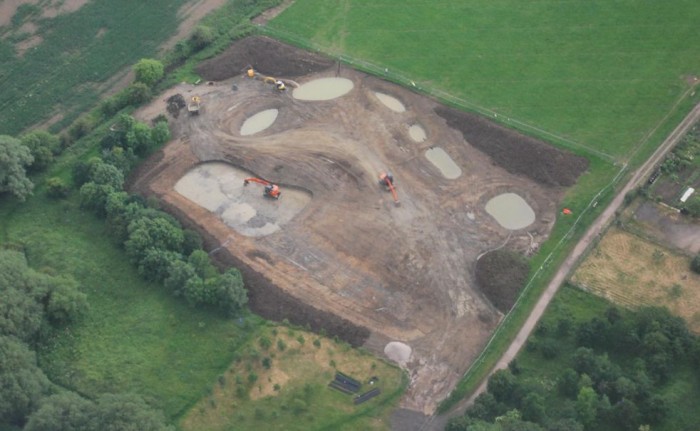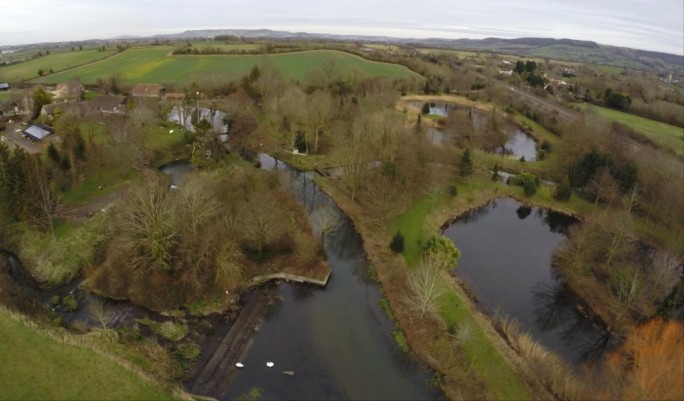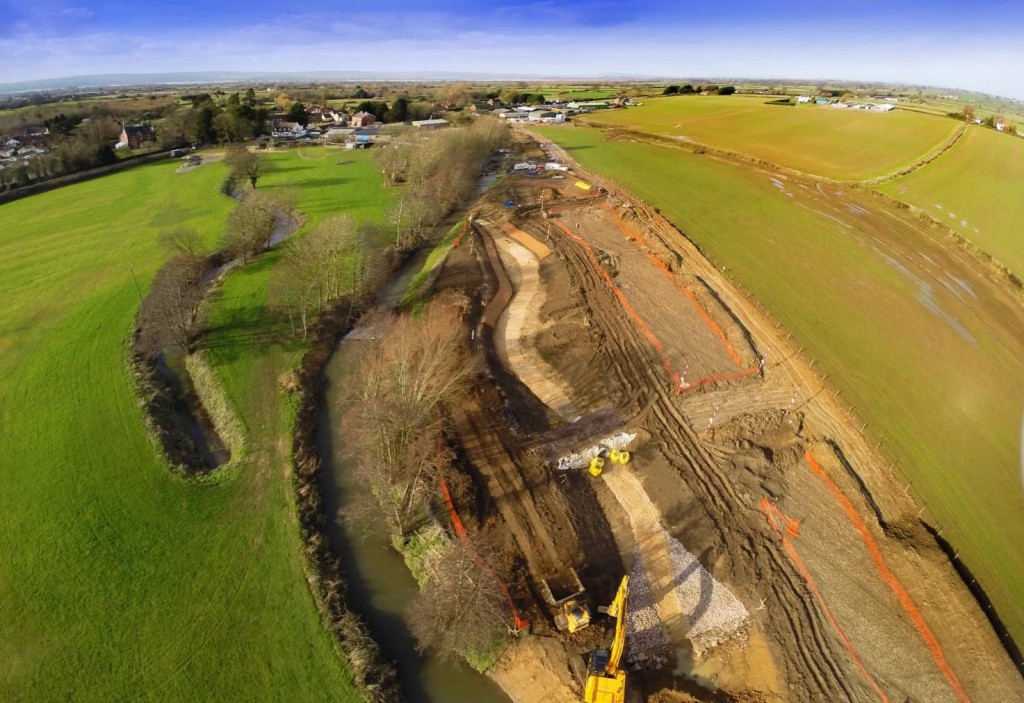The privatisation of our water was claimed to be for the raising of investment for environmental improvements within a “natural monopoly”. Sustainable drainage (SUDS) was originated to achieve this at low cost, but after a quarter of a century it is still not being properly implemented. The reason is that the principles underpinning our water industry are both unsafe and illegitimate in almost all respects.
WHEN THE LATE Kirsty MacColl gave up her Ealing garden to a rain and sewage recycling reed bed, cistern, and pond complex for the 1991 BBC documentary Don’t Go Near the Water, she wanted to both inform about and counter water privatisation. By retaining rain and wastewater within her property, she would take responsibility for it and consequently reap the benefits – basic concepts still lost on our water industry, its regulators, planning authorities and the politicians claiming an informed oversight.
Following on from Kirsty’s programme, innovative architects proposed a housing development where all rainwater would be captured for reuse. The local Water Company, however, announced legal proceedings, as “they owned all the rainfall in the region” – the same water company that a few years later was pilloried for selling off its urban reservoirs (for property development) and for its inability to maintain supply during drought. An example of inept understanding of existing legislation, water engineering, and simple common sense. Raised flood risk throughout the UK is still primarily the result of such deficiencies.
“These could be built on a community basis, like a water-garden that the public could enjoy,” said Julian Jones,1 designer of MacColl’s water system. The intention was to patch-up great holes neglected by unnatural water company monopolies. The Sustainable Urban Drainage Systems concept (SUDS) that MacColl had pioneered is now the normal requirement for any major new housing development, but it is still incorrectly applied to wider river catchments and to municipal planning in general.

Taking Responsibility : A £100K storm water SUDS system being installed by a Local Authority to enable disconnection from an adjacent uncontrolled & untreated sewer. Tamás Böröndi, Water21 (Churchdown Council)
Taking responsibility – because no-one in authority will
The SUDS concept of intercepting or capturing sewer run-off arose from the bitter experience of Stroud’s child meningitis outbreaks during the early 1980s, clustering downwind of the numerous river weirs in the steep Stroud Valleys. Cutbacks in infrastructure spending in the run-up to water privatisation meant over 50 storm sewage-overflows continuously discharged into local streams. Post privatisation, the overflows were dangerously blocked-up – resulting in fractured sewers and further uncontrolled discharges onto the surrounding land.
Jones’s voluntary group, Water21 (which includes many post-graduate students), continues as part of the non-partisan Agenda 21 (LA21) “community led” process arising from the 1992 Rio Conference. The intention is one of “taking responsibility”, because, as Jones puts it, “no-one in authority will”. The latest EU legislation actually stipulates this, but progress is slow, hindered by vested interests and regulators rigid in their protection of antiquated concepts of Victorian water and sewage treatment.
By 1993 Jones had formally scoped-out possibly the world’s first full Catchment Based Approach (CaBA) at the request of Stroud District Council (SDC).2 But by 2004, when Water21 achieved agreement with Severn Trent Water to implement a UK pathfinder scheme to completely control both sewer and river flooding, SDC announced their own competing scheme – both proposals failed. Local party-political differences and obfuscatory council officials being the ultimate source of failure.
“Putting a nail through the heart of this public participation thing”
The LA21 participatory process, vital for overcoming deficiencies in planning infrastructure by remote corporate consultants and regulatory officials, is formalised within the EU Water Framework Directive. Yet, when Environment Agency chief Barbara Young was called before a Select Committee in 2007, she stated, “I would like to put a nail through the heart of this public participation thing right from the start … so we are not even going to try to do that.” 3
Brutal defiance of the law by the EA spelled further costly delays for Water21, who following the 2007 UK floods were finally getting underway devising the first ever hydraulic catchment planning methodology to resolve both flood and drought in the treacherously steep Slad Valley, while restoring base (normal) river flows to reduce dangerous accumulations of pathogenic sediments during extended periods of low flow.

4 metre high storm weir (lower left) on River Cam, Gloucestershire, and stilling area (just above) that collects pathogenic sediments, created in a £5 million flood scheme 3 decades ago. The weir prevents fish passage and sprays sewage particulates over nearby Stroud during storms
No public health standards for rivers or weirs
Despite the catalogue of risks to health from direct contact with sewage, successive UK Governments have allowed the practice of discharging untreated sewage into the environment. Levels of risk were previously based on a 1959 study, by the UK Public Health Laboratory Service, which concluded “bathing in sewage-polluted sea water carries only a negligible risk to health”. A further study (Moore, 1974) stated, “Microbial standards for bathing water are irrelevant to the public health”.
It was when Dr David Wheeler, of the Robens Institute, announced his 1990 findings on the longevity of sewage viruses in the sea (which can survive for months, at least) that Jones’s worst fears seemed confirmed. Calling Wheeler to ask his view on such risks at river-weirs, he replied, “You do not even want to think about that.” Water company directors were even less cordial.
It turns out that the Water Industry isn’t really regulated in the public interest at all. The concept of holistic catchment management, where capturing rainwater against dry spells should be common sense, is still not remotely the norm – even though it is promoted within the EU Water Framework Directive, the theoretical legal cornerstone of all UK water legislation.
The lack of environmental health standards for sewage is the result of a mismatch between what little can be achieved by conventional civil engineering and what is actually required. Yet, a largely soft-engineered, rural SUDS approach can overcome this deficit by lowering installation costs and breaking-up sewer networks into hydraulically manageable units.
Rather than address reality the Environment Agency misrepresents it
Rather than address reality, the Environment Agency (whose Public Relations staff has ballooned tenfold, to 350) simply misrepresents it. In 2003 they trumpeted “… the Thames is now one of the cleanest rivers in the world. It’s even safe to swim in.” Yet only two years later they had to admit the obvious, “38 million tonnes of sewage despoiled the river.” 4 In 2011, the RSPB accused the EA of publishing river quality data that was “propaganda … a clear attempt to mislead the public.” 5
The original Victorian water management regime did include some common sense aspects of infrastructure and land management – but even these are now lost, as they do not suit the short-term profit interests of “big business”. Once Water21 completed their planning methodology in Slad (applicable to all UK rivers) they were pushed aside by the EA, allowing one such major corporation to then waste £200,000 (of the £500,000 budget allocated) planning hard-engineered structures that would never be built – all because they lacked local knowledge and expertise.
The EA operate their own “closed-shop” cartel of pre-selected consultants and contractors – the “water and environment management framework” (WEM). All being large, remote corporations, who cannot hope to achieve the level of local knowledge necessary to implement the appropriate solutions required – creating instead only an illusion of activity, while squandering £billions.
Ignoring local expert knowledge, remotely based EA consultants proposed a £3million pair of unfeasible 9 metre high concrete dams in Slad. Water21 were then asked back to join the project’s Flood Board, and instructed to plan dispersed small earth-dams to capture a notional 1/75 year storm as a test deployment. Water21 found a +300% capacity to achieve this, along with willing farmers to provide the land, and the potential boosting of food productivity from the stored water. Once this was achieved, the EA ceased collaborating, and eventually pulled the funding altogether, re-launching it without Water21 but in partnership with Stroud District Council and another major engineering corporation.
A brighter future?
And so the sorry tale continues. Today, our water crises are more pressing than ever. It is only when all parties put down their short-term self-interest and begin to work together towards a common long-term goal that a win win solution will be found for all – a solution that will not only help to finally solve many of our water related problems, but which has the capacity to spread prosperity down to all people within a local water catchment area, and ensure a healthy supply of clean, fresh, living water for generations to come.

Greenwash : A £300K fish pass built without local consultation on the River Cam near Stroud in order to bypass a 1.25m high weir that only required a load of large rocks to improve existing fish passage – while neglecting a much higher 4m high weir just upstream
References
- Honorary Water Scientist Gloucestershire NHS & Cranfield Health.
- Lydia Williams, Stroud Urban Wetlands, 1993. Julian Jones, Architectural Design 113, 1994.
- Baroness Young, Select Committee on European Union WFD, Hansard, 17 January 2007
- The Guardian, August 14, 2003 & February 26, 2005
- Mark Avery, RSPB Director of Conservation, The Sunday Times, January 16 2011

Sorry, the comment form is closed at this time.